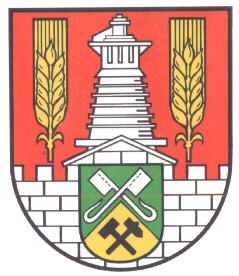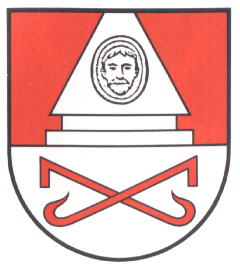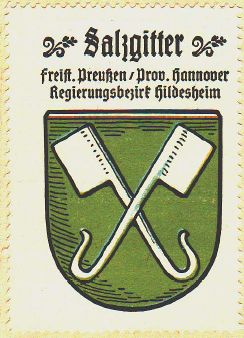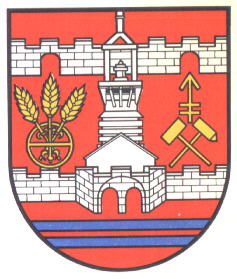Salzgitter
This page is part of the German heraldry portal Deutsche Wappensammlung |
Heraldry of the World |
|
German heraldry:
|
Selected collector's items from Germany:
|
SALZGITTER (1942-1951 Watenstedt-Salzgitter)
State : Niedersachsen
Urban district (Kreisfreie Stadt) : Salzgitter
Additions : 1942 Barum, Beddingen, Beinum, Bleckenstedt, Bruchmachtersen, Calbrecht, Drütte, Engelnstedt, Engerode, Flachstöckheim, Gebhardshagen, Gitter, Gross Mahner, Hallendorf, Heerte, Hohenrode, Immendorf, Lebenstedt, Lesse, Lichtenberg, Lobmachtersen, Ohlendorf, Osterlinde, Reppner, Ringelheim, Salder, Thiede, Watenstedt; 1974 Sauingen, Üfingen
Official blazon
(de)
Origin/meaning
The arms were granted on January 24, 1951.
The arms show a city wall, to characterise the city character of Salzgitter. The two wheat-ears and the blast furnace symbolise the agriculture and industry respectively. The small shield shows in the lower half some miner's tools, symbol for the important mining in the area. The upper half shows two salt hooks (see below).
The history of the arms of Salzgitter is rather complicated.
In the early 19th century the city used the old arms of Salzliebenhalle, one of the predecessors of Salzgitter city. These arms showed a pyramid with a man's head and in the lower half two crossed salt-hooks.
| Arms of Salzliebenhalle |
In 1854 the city decided to adopt new arms, with only the two salt-hooks. Unfortunately these were drawn as axes and the colours were changed into green and silver. Why the colours were changed is not known.
| Arms of Salzgitter from 1854-1936 |
The arms by Hupp in the Kaffee Hag albums +/- 1925 |
In 1936 the council wanted to readopt the old arms. However, the National-Socialist Regime did not agree with the man's head and pyramid. In 1936 new arms were granted showing the salt-hooks, properly drawn, and a plain red upper half.
| Arms of Salzgitter from 1936-1942 |
In 1942 Salzgitter was enlarged with 28 other municipalities and received the name Watenstedt-Salzgitter. The new municipality did not apply for new arms until 1946. After a competition a very complicated design was granted. The new arms showed two city walls, the one in front with a gate, between the walls a furnace flanked by on the one side the medieval symbol for salt, from which rose three wheatears, and on the other side two crossed miner's tools and the medieval symbol for iron. In the base of the shied were two blue bars. The arms thus showed the fact that Salzgitter was a city, with iron and salt mining and manufacturing the main sources of income, but with some agricultural element (wheatears) as well. The two bars represent the local channel.
| The arms of Watenstedt-Salzgitter (1947-1949) |
As the above arms were not officially granted, and as the State Archives and the (then British) government did not approve of the design, new arms were made. After another contest and many different designs, the present arms, as shown above, were designed. At the same time the name Salzgitter was restored.
Contact and Support
Partners:
Your logo here ?
Contact us
© since 1995, Heraldry of the World, Ralf Hartemink 
Index of the site
Literature : Rabbow, 2003; Stadler, 1964-1971, 8 volumes; Kaffee Hag Albums, 1920s



















